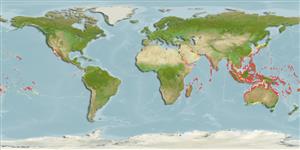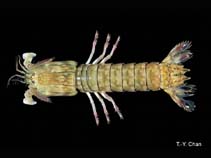Gonodactylus chiragra (Fabricius, 1781)
| Native range | All suitable habitat | Point map | Year 2050 |

|
| This map was computer-generated and has not yet been reviewed. |
| Gonodactylus chiragra AquaMaps Data sources: GBIF OBIS |
Classification / Names Common names | Synonyms | CoL | ITIS | WoRMS
Malacostraca | Stomatopoda | Gonodactylidae
Environment: milieu / climate zone / depth range / distribution range Ecology
Benthic; depth range 0 - 30 m (Ref. 96667). Tropical
Distribution Countries | FAO areas | Ecosystems | Occurrences | Introductions
Indo-Pacific: French Polynesia to Japan, Australia and the Indo-Malayan region.
Length at first maturity / Size / Weight / Age
Maturity: Lm ? range ? - ? cm Max length : 10.5 cm TL male/unsexed; (Ref. 3148)
Short description Morphology
Sexual dimorphism, males have dark greenish coloration while females are whitish green.
Inhabits shallow water especially in upper intertidal zone (Ref. 3510, 80410) in reef flats and tidal flats under rocks and boulders or inside coral or rock crevices (Ref. 87055). Subtidal (Ref. 106854). It actively moves in between coral heads for prey (Ref. 80410).
Life cycle and mating behavior Maturity | Reproduction | Spawning | Eggs | Fecundity | Larvae
Some members of the order Stomatopoda pair for life and some come together only to mate. Males produce sperm ducts rather than spermatophores; females can brood a maximum of 50,000 eggs. Life cycle: Eggs hatch to a planktonic zoea which lasts for 3 months.
Main reference
References | Coordinator | Collaborators
Ahyong, S.T. 2001. (Ref. 3099)
IUCN Red List Status (Ref. 130435)
CITES status (Ref. 108899)
Not Evaluated
CMS (Ref. 116361)
Not Evaluated
Threat to humans
Harmless
Human uses
| FishSource |
Tools
More information
Internet sources
BHL | BOLD Systems | CISTI | DiscoverLife | FAO(Publication : search) | Fishipedia | GenBank (genome, nucleotide) | GloBI | Gomexsi | Google Books | Google Scholar | Google | PubMed | Tree of Life | Wikipedia (Go, Search) | Zoological Record
Estimates based on models
Preferred temperature
(Ref. 115969): 24.4 - 29.3, mean 28.3 (based on 3706 cells).



